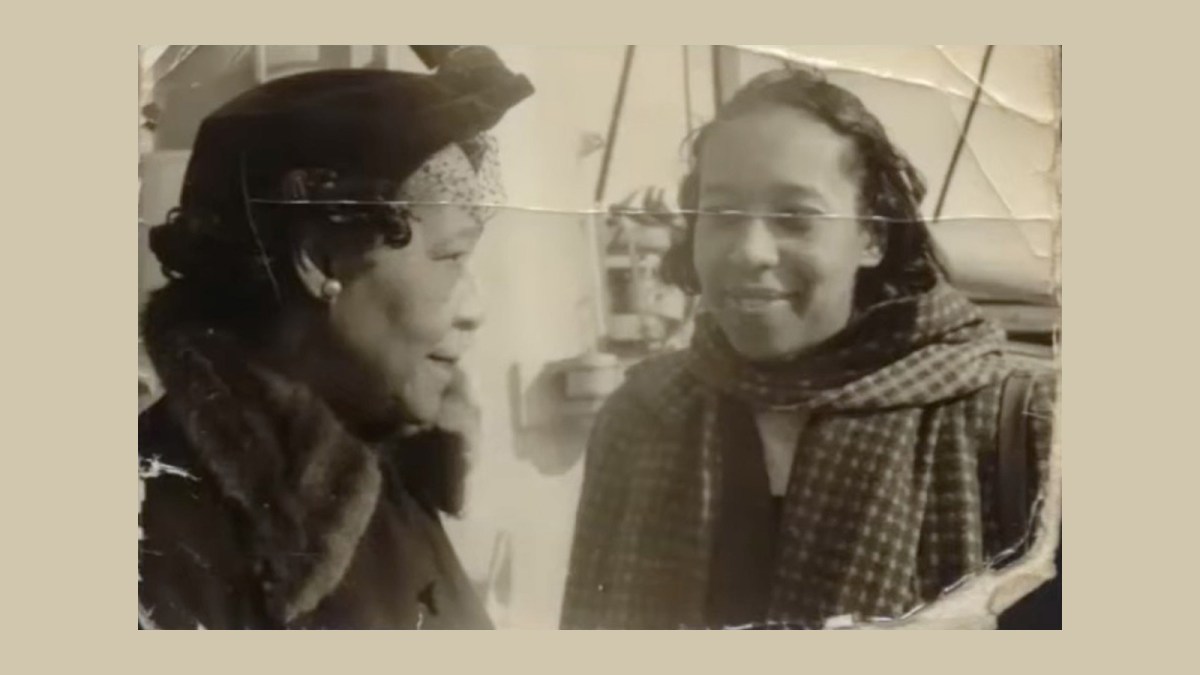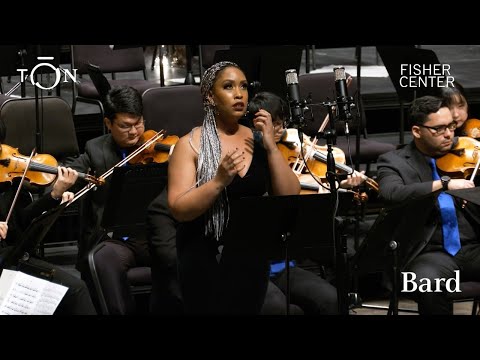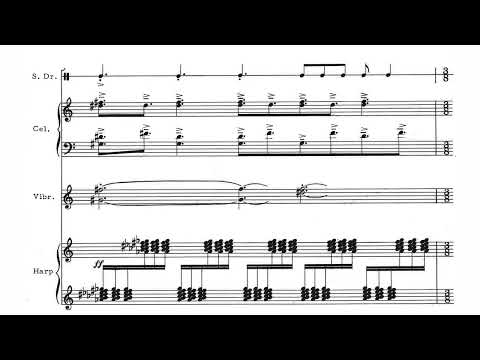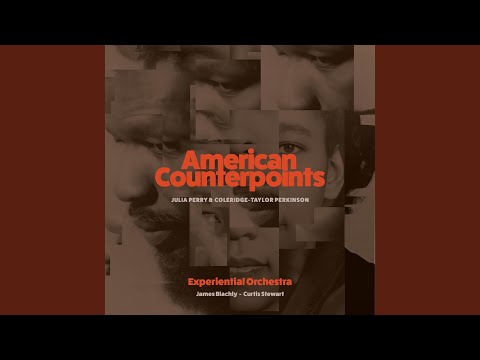I am always bitter about going to the established-yet-edgy New York venue (Le) Poisson Rouge—their cheapest beer is $10—but their programs make it impossible to stay away. The kickoff event for the Julia Perry Centenary Festival and Celebration on March 13 was no exception. Even more irresistibly, it was one of the first-ever concerts dedicated entirely to Julia Perry’s music.
The concert featured PUBLIQuartet, Samantha Ege, and Laquita Mitchell, and began with a toast to the elusive Black modernist composer. Beer prices aside, the location was fitting for its connection to Perry’s arrival in New York in 1945. About ten minutes’ walk from the venue, the 21-year-old composer had given an impromptu vocal performance at Café Society, New York’s first integrated club. (Billie Holiday had premiered “Strange Fruit” there six years earlier.) After Perry’s performance, they offered her $250 a week to sing at the venue, but she turned down the gig to dedicate herself fully to composing. Twenty years later, she became the first woman of color to have a piece performed by the New York Philharmonic, at a time when the orchestra had no Black or female players.
“How many of you have never heard Julia Perry’s music before?” soprano and scholar Dr. Louise Toppin asked the audience at LPR. Half the crowd raised their hands. Then Perry fans and initiates alike were invited to toast with their glasses (or $10 Narragansett) in honor of what would have been Perry’s 100th birthday on March 25. It was one of the festival’s many moments when you could feel a kind of electric circuit of enthusiasm between those who had been tracking down her work for years, and those just joining the party.
For the latter group, a good place to start is Perry’s earliest piece, Prelude for Piano (1946). PUBLIQuartet gave the premiere of a quartet arrangement of the Prelude, highlighting its warm yet frank world of dissonance, where suspensions reveal a troubled underbelly then melt into pockets of resolution. Born in segregated Lexington, Kentucky in 1924, Perry was a two-time Guggenheim recipient and Tanglewood fellow who studied composition with Nadia Boulanger and Luigi Dallapiccola. The almost-spoken feel of Samantha Ege’s performance of “Miniature for Piano” and Laquita Mitchell’s rendition of “By the Sea” and “How Beautiful are the Feet” captured how Perry’s style cuts to the core, using serialism as a medium for intimate expressivity.
The evening closed with Jannina Norpoth’s arrangement of Perry’s “Ye Who Seek the Truth” and Curtis Stewart’s genre-bending quartet/spoken word homage to Perry, “We Who Seek.” Both are on the new Experiential Orchestra album “American Counterpoints,” conducted by James Blachly, which features gripping and desperately needed recordings of Perry’s work. While listening, I was struck by how much Perry’s music inspires an active response in her listeners—from arranging, to researching, to confronting hairy copyright issues, to composing new works. Beyond the obvious fact that her music has been neglected, it’s like Perry’s pared-down chords seep into your skin, relaying a message that feels both clear and mysterious. As in her frequently programmed work, “Stabat Mater,” something about her harmonies captures both profound grief and the beauty to be found in grief’s shadows.
The latest from VAN, delivered straight to your inbox
I was drawn to fly cross-country to the festival because Perry’s music and biography are notoriously hard to find. In 2024, you can throw a stick and hit a Schoenberg Centennial concert, but four entire days dedicated to Julia Perry at major New York venues was a historic event, featuring numerous premieres and much newly-discovered information. (If you missed it, there are others scheduled in Missouri, Massachusetts, and recorded from England). Due to a combination of structural barriers for Black women composers and problems with Perry’s estate, many of her scores have been lost or destroyed; biographical material is scarce, and at least 37 of her surviving manuscripts are frozen from licensing due to copyright issues. (A team including Dr. Toppin and Christopher Wilkins, conductor of the Akron Symphony, has been trying to track down Perry’s family for years.)
Due to this lack of information, the conference the next day at Mannes School of Music had the feeling of a collective biographical project. Musicologist Angela Hammond traced Perry’s genealogy by combing through newspapers for hours (despite a lack of preservation of Black-owned media), discovering that Perry’s great-grandfather had escaped twice from slavery, at one point hiding in a hollowed-out tree for seven years. Perry’s father was a doctor and pianist who ran for local government despite death threats from the Ku Klux Klan. Julia was named after her great-grandmother, who was born into enslavement. Many women in her family were community leaders. This fierce family commitment to freedom sheds light both on Perry’s strength and her uncompromising exploration of many compositional styles.
As Christopher Wilkins discovered through interviews with Akron locals (Akron Symphony’s Julia Perry Project is excellent), Perry had been a self-directed, secretive child, the fourth of five girls. Her childhood neighbor, Ophelia Averitt, remembered Perry eating lunch by herself at school to study her music. At Westminster Choir College and later Juilliard, Perry continued to be private and independent—but had a firm confidence she relied on in public. Garrett Schumann presented on her time in New York, sharing the clipping of her Café Society debut, and an audio clip of her cracking jokes with Aaron Copland at Columbia University about how she’d rather not be teaching.
The scholar Gayle Murchison proposed Perry as an emerging theorist, situating groundbreaking pieces like “Homunculus C.F. for Ten Percussionists” in the context of Roberto Lupi’s Armonia della Gravitazione, which uses the laws of gravity as a lens for tonality. Columbia doctoral student Sasha Doster explored Perry’s political writings and offered two more views of the piece. She cited Kendra Preston Leonard’s point that Perry’s minimalism in “Homunculus C.F.” preceded that of Riley, Glass, and Young, and George Lewis’s connection of the piece with African pianism. (Leonard created a Julia Perry Working Group, another collective biography source.) Music theorist Philip Ewell contextualized her reception with that of Black composers both past and present, and Ege gave a kaleidoscopic lecture-performance, later asking Doster how Perry’s music might be understood in the context of Black women’s political anger.
One of the most maddening details of Perry’s life was that her New York Philharmonic debut was riddled with mistreatment behind the scenes. We looked at a 1965 letter from Perry to the New York Philharmonic, asking for her score “Liberation for Orchestra” to be shown to Leonard Bernstein, at a peak moment of the Civil Rights Movement. Her request was ignored; most maddening, the score has since been lost. Lacking the funds for a copyist, she painstakingly wrote out all her orchestral parts by hand, but they were rejected by the orchestra librarian. Ultimately, Perry could not afford to travel to New York to attend the performance.
The story showed how silent barriers, lack of support, and costs keep some of the best American musicians from being heard; the price of festivals, tuition, rehearsal spaces (to say nothing of Narragansetts) can be prohibitive. Perry’s story exemplifies how pernicious tokenism can be in programming, when one-off performances or community events are mistaken for real structural support. It is no secret that these barriers continue in 2024. At the conference, James Blachly told the audience that a skeptical response he got from a high-profile institution was: “Is her music any good?” Yes, he said, describing her as one of the most important American modernist composers.
“But is it really good?”
“You just have to respond to that by asking: ‘Do you think ‘La bohème’ is really good?’” Philip Ewell offered from the audience.
The two other concerts lined up in the festival made clear that really good is an understatement. They also showed the real-time value of these events, even beyond sharing really good music. Dr. Toppin, who founded the African Diaspora Music Project, previously got in touch with one of Margaret Bonds’s relatives to inherit her estate through an interview Toppin gave on NPR. After five years of searching, Dr. Toppin was shocked to discover that Perry’s Harlem-based niece, grandnephew, and grandniece were in the audience at the second festival performance. They, in turn, were surprised to discover a New York music festival dedicated to their aunt.
Her family members got to hear premieres of some of the best Perry music I have ever heard. The “Woodwind Quintet or Symphony No. 13,” which Perry wrote with her left hand following a stroke that paralyzed her right side, was exceptional. Replacing the standard French horn with alto saxophone, its rhythms were thrilling, and took brilliant advantage of the instrumentation to build dense, shifting columns of sound. One of the performers, bassoonist and composer Brad Balliett, described the performance as a joy: “It’s one of those pieces that both reveals more and more levels of detail as you study it, while still being rhythmically exciting to experience live.”
The largest event was the festival’s final performance at Alice Tully Hall, with the New York premiere of Perry’s Concerto for Violin. The score had taken violinist and composer Roger Zahab 45 years to construct from Perry’s shaky, post-stroke handwriting and revised scores scattered across the country, but Curtis Stewart gave a searing performance in lockstep with the EXO under James Blachly. The piece is a technical workout, especially in the second cadenza, but Stewart is so fluent in Perry’s language that the moments of virtuosity never felt like empty displays, but essential to the expression of each phrase. With such a range of emotions, meters, and colors contained in a single piece, I was left hoping that Stewart’s powerful rendition would lead to even more interpretations.
The festival culminated with “Ye Who Seek the Truth,” arranged for orchestra and chorus by Jannina Norpoth, with Louise Toppin as the soloist. Both the concert and the final piece brought together the EXO, Ruckel Middle School Chorus (Niceville, Florida), Sandra Day O’Connor High School Orchestra (San Antonio, Texas), and New York conservatory students. Abstractly, I had been excited by this shared bill, but the first hour of the show by the younger student ensembles featured run of the mill pieces and cringy highlighting of solely white soloists. Inadvertently, it felt like a reminder that for all of New York City’s diverse programming, the real equity mountain to climb is in music education across the country. It felt fitting, then, that Perry’s text had the last word, sung powerfully by Toppin: Follow me, follow me, o ye who seek the truth. ¶
Subscribers keep VAN running!
VAN is proud to be an independent classical music magazine thanks to our subscribers. For just over 10 cents a day, you can enjoy unlimited access to over 875 articles in our archives—and get new ones delivered straight to your inbox each week.
Not ready to commit to a full year?
You can test-drive VAN for one month for the price of a coffee.






